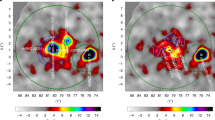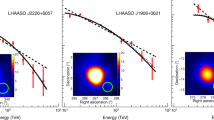Abstract
The Crimean Observatory group have detected γ rays from the direction of the X-ray source Cyg X-3 (refs 1–5): rays of energy 1012eV were observed using the atmospheric Cerenkov technique. Measurements with satellite-borne instruments in the 108eV region have shown effects from Cyg X-3 in one case6, but not in another7. Similarly, γ rays have been seen in some balloon flights8, but not in those of McKechnie et al.9 nor of White et al.10. A study using the atmospheric Cerenkov technique at 1011eV showed no effect11, though it has been shown to be compatible with the Crimean result4. We report here observations taken at Mount Hopkins Observatory, Arizona (altitude 2.3 km) in April, May and June 1980 using a similar system to that of Stepanian et al.3, which seem to confirm, at least qualitatively, the Crimean results.
This is a preview of subscription content, access via your institution
Access options
Subscribe to this journal
Receive 51 print issues and online access
$199.00 per year
only $3.90 per issue
Buy this article
- Purchase on Springer Link
- Instant access to full article PDF
Prices may be subject to local taxes which are calculated during checkout
Similar content being viewed by others
References
Vladimirsky, B. M., Stepanian, A. A. & Fomin, V. P. Proc. 13th int. Conf. Cosmic Rays 1, 456–460 (1973).
Vladimirsky, B. M., Neshpor, Yu. I., Stepanian, A. A. & Fomin, V. P. Proc. 14th int. Conf. Cosmic Rays 1, 118–122 (1975).
Stepanian, A. A., Vladimirsky, B. M., Neshpor Yu, I. & Fomin, V. P. Proc. 15th int. Conf. Cosmic Rays 1, 135–140 (1977).
Neshpor Yu, I. et al. Astrophys. Space Sci. 61, 349–355 (1979).
Mukanov, J. B., Nesterova, N. M., Stepanian, A. A. & Fomin, V. P. Proc. 16th int. Conf. Cosmic Rays 1, 143–146 (1979).
Lamb, R. C., Fichtel, C. E., Hartman, R. C., Kniffen, D. A. & Thompson, D. J. Astrophys. J. Lett. 212, L63–L66 (1977).
Bennett, K. et al. Astr. Astrophys. 59, 273–274 (1977).
Galper, A. M. et al. Proc. 15th int. Conf. Cosmic Rays 1, 131–134 (1977).
McKechnie, S. P., Mount, K. E. & Ramsden, D. Astrophys. J. Lett. 207, L151–L154 (1976).
White, R. S. et al. Nature 284, 608–610 (1980).
Weekes, T. C. & Helmken, H. F. Astrophys. J. 228, 531–5 (1979).
Mason, K. O. & Sanford, P. W. Mon. Not. R. astr. Soc. 189, 9P–14P (1979).
Eisner, R. F. et al. Astrophys. J. 239, 335–344 (1980).
Bonnet-Bidaud, J. M., Ilovaisky, S., Manzo, G., Molteni, D. & Robba, N. R. Astr. Astrophys. 62, 275–276 (1978).
Bignami, C. F., Maraschi, L. & Treves, A. Astr. Astrophys. 55, 155–158 (1977).
Author information
Authors and Affiliations
Rights and permissions
About this article
Cite this article
Danaher, S., Fegan, D., Porter, N. et al. γ-Ray observations of Cygnus X-3 at energies of 1012eV. Nature 289, 568–569 (1981). https://doi.org/10.1038/289568a0
Received:
Accepted:
Issue Date:
DOI: https://doi.org/10.1038/289568a0
This article is cited by
-
Constraints on cosmic-ray observation of Cygnus X-3
Nature (1985)
-
A 12.6-ms pulsar in Cygnus X-3
Nature (1985)
-
A design study of atmospheric Cerenkov radiation telescope for very high energy gamma-ray astronomy
Astrophysics and Space Science (1985)
-
Magnetic pair production in Cygnus X-3 and a cut off in the γ-ray spectrum
Nature (1984)
-
Implications of 1016 eV γ rays from Cyg X-3
Nature (1984)
Comments
By submitting a comment you agree to abide by our Terms and Community Guidelines. If you find something abusive or that does not comply with our terms or guidelines please flag it as inappropriate.



